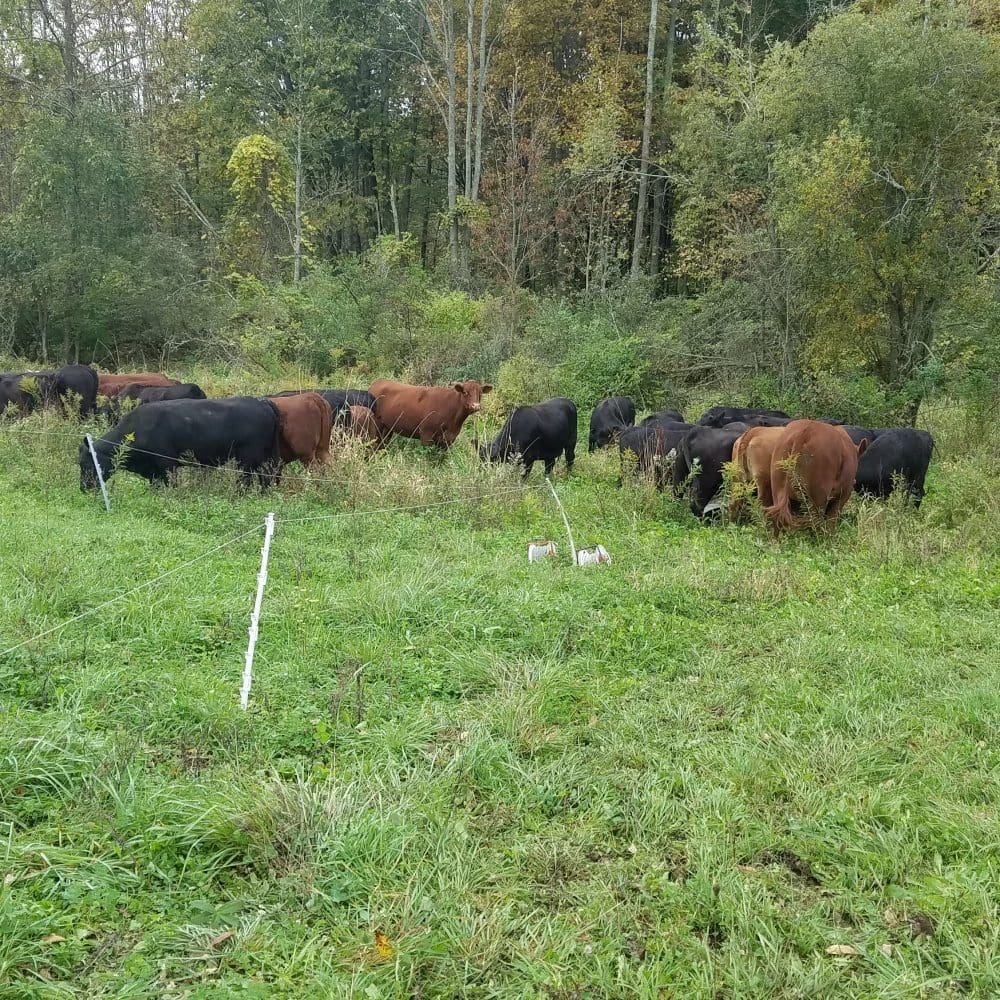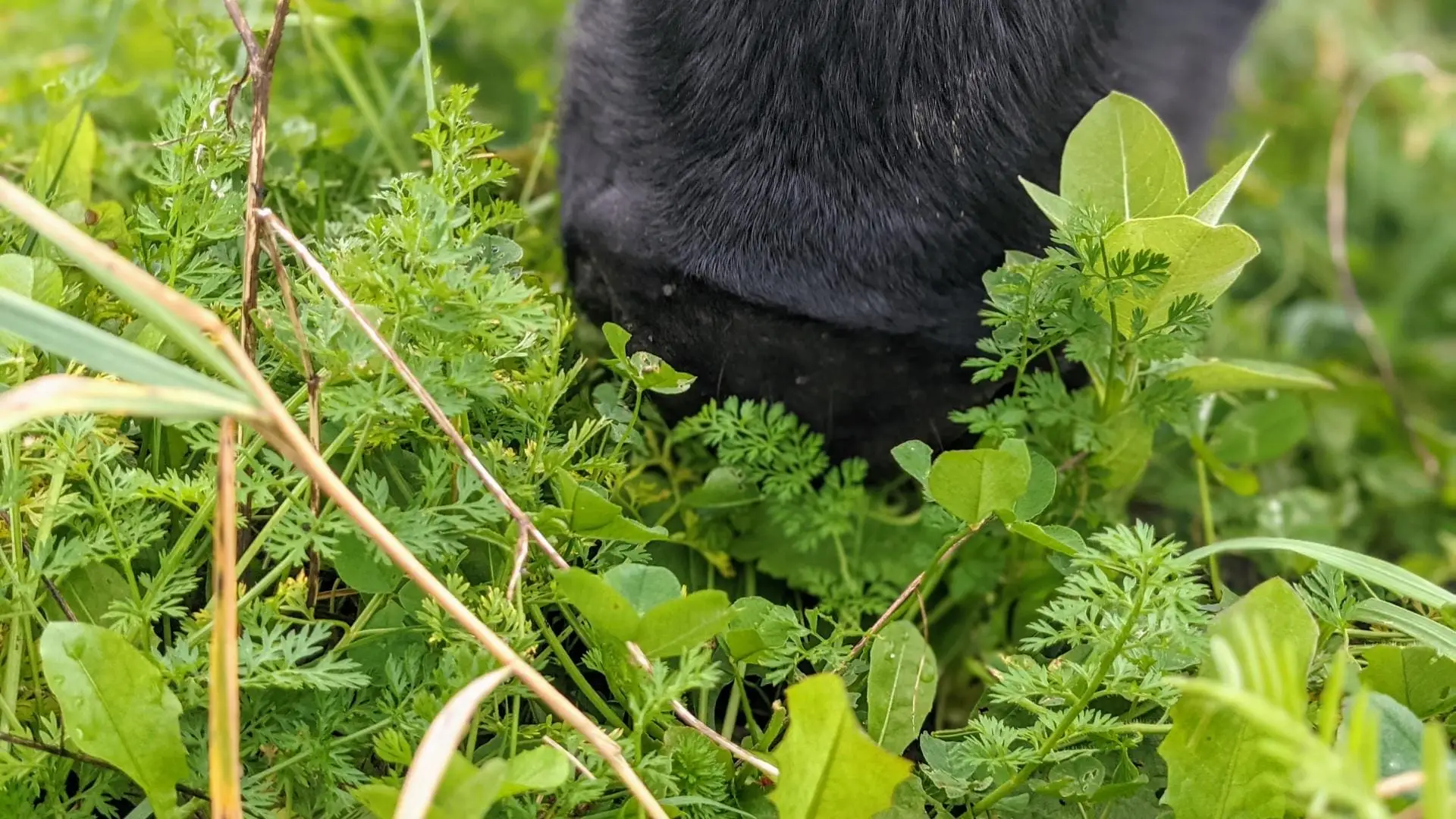At Wrong Direction Farm we take grass fed beef seriously. A lot of our customers come to us with questions, wondering what “grass fed” and “grass finished” really mean. And rightly so, because there is plenty of confusion in the marketplace.
What We Talk About When We Talk About Grass Fed
When we say grass fed beef, we mean that our cattle only eat the leafy plants that grow in our pastures. The word grass is a bit too limiting, because a healthy field will include a diverse range of plants that aren’t technically grasses, such as clovers, vetch, dandelions, burdock, etc. But for simplicity we stick with the umbrella term “grass.” During the summer they eat the grasses directly from the pastures. During the winter they eat hay, which is grass that has been rolled up into bales. We never feed them corn or other grains or grain byproducts. The cattle eat the food they are best adapted to eating. Yes, this means that they don’t grow as quickly as commercial cattle, but they grow healthier and do not require antibiotics and hormones.
Better Grass, Better Beef, Better World
Just putting cattle out in a pasture isn’t enough to produce premium grass fed beef. Truly great grass fed beef comes from managing the cattle and managing the grass. Allowing cattle (or really any animal) continuous access to a plot of ground results in a variety of problems, including overgrazing, erosion, soil compaction, and water runoff.
We manage our grass and our herd to ensure that they are peripatetic, that is continuously on the move. At least once each day, and sometimes several times each day, we move them to fresh grass. The model we are following is the movement of wild herds of herbivores (think herds of bison, wildebeest, or reindeer). Wild herds don’t stay in the same area all the time; rather they move seasonally with the changes in weather and with the pressures from predators. This movement distributes the impact from the animals. Rest periods between grazings provide plants sufficient time to recover. This grazing action has been identified as one of the greatest long term contributions to climate stability, increasing soil fertility by carbon sequestration as herbivores work in partnership with grasslands.

As we manage the pastures over the course of years we see grasses flourishing, and we notice an increase in plant, insect, and bird species diversity. The growing soil fertility enhances the forage growth and, not surprisingly, the quality of the beef improves. Unlike commodity beef which has a uniformly bland flavor profile, our grass fed beef has great taste because of all the different plants that leave their signature flavor compounds in the beef fat. Richer soil leads to healthier pastures, which leads to amazing beef.
How Grass Alone Can Build a 1200 Pound Steer
If you think about it, it is hard to imagine how any animal could make a complete diet only from grazing stringy green leaves. Sure, we love a big fresh salad. But we can’t live on grass, so how do cattle thrive on it?
Cattle, sheep, goats, and many other specialized herbivores have a four stage stomach complex, the largest of which is called the rumen (hence the designation “ruminants” for these types of animals). Omnivores and carnivores lack this organ structure. Instead of attacking food with acids as a human stomach does, a rumen is a flexible fermentation tank. Cattle have colonies of beneficial bacteria within the rumen that ferment the less digestible plant fibers and extract the basic sugars and nutrients. This amazing arrangement allows cattle to sustain all their needs from plant fibers that otherwise would be indigestible.

Why Not Grain?
So at this point the question might arise, why not feed cattle grain? It makes them grow faster. And the industry seems to like it.
Really the only positive thing to be said for grain feeding of cattle is that it produces a lot of cheap beef for a few big companies. That’s it.
The problem with grain feeding for cattle begins with the fact that they are ruminants, that their digestive system isn’t like a pig’s or a chicken’s. They are not biologically well-suited to eating large amounts of concentrated starchy grains. Cattle will grow and fatten on corn or other grains, but they do that at the expense of their health. The rumen biology is upset by the grain, leading to acidification in the wrong part of their stomach where they can’t stand high acid concentration. This develops into chronic diseases related to inflammation and immune system failures. Rather than fixing the root problem, the beef feedlot industry turns to antibiotics and hormones to prop the cattle up.
Eating beef from metabolically-compromised, immunodeficient cattle not surprisingly leads to nutrition problems for humans. There are many studies showing inappropriate fatty acid balances in grain fed beef. As understanding has grown of the importance of certain fats in our diets, grass fed beef consistently has these at healthy levels whereas grain fed beef is all askew.
Another consequence of grain feeding is the way it has allowed the cattle and beef industry to become incredibly concentrated. The median cattle grain feeding operation in 2017 raised 43,000 cattle. Many of the newer mega-feedlots house in excess of 100,000 cattle. This feedlot system is responsible for untold pollution, disease outbreaks, and environmental degradation, not to mention the steady hollowing out of rural communities that previously were supported by smaller, more distributed agricultural networks.
Going Beyond the Grass Fed Beef Label
The term “grass fed” is sometimes misused with the intent of confusing consumers. As we’ve shown, producing grass fed beef is more than putting a cow on grass. It is really a system of farming that requires an underlying ecological understanding of grasslands, a biological understanding of cattle, and a practical ability to manage the interaction of these two.
Because the term grass fed is not a consistently regulated term in the United States there is no way to hold anyone to a specific standard. And even if there were a standard, we’ve seen in the past when the USDA defines a term they often do so while creating more loopholes. We’re not optimistic that there ever will be a perfect way to label beef to inform customers about what they are really getting. Much of the beef sold as grass fed is actually fed grain and grain byproducts, with the disclaimer that the cattle were also fed grass. This clearly is a deception, but it is allowable under current labeling laws.
Interestingly, most (about 85%) of the beef sold as grass fed in the United States is actually imported from other countries but given a final packaging in US-based processing plants. This processing step allows it to be labeled as “Product of the USA.” At this point, the supply chains are so opaque and convoluted that we are not aware of any trustworthy large-scale grass fed beef brands.
Knowing for Certain
The only really sure way of knowing what you are eating is knowing your farmer. “Know your farmer” has become a trite phrase, but labels aren’t going to tell you what is behind that steak on your plate. At Wrong Direction Farm our model has always been to be a transparent farm. We began this farm because we wanted to be confident in the food we were eating. Being real about what we produce is essential to who we are. If that kind of food integrity matters to you, then you’ve found the right place.
Ready to Try Some?
We deliver our grass fed beef and our selection of pasture raised poultry and pork to customers each week. Your order will arrive ice cold in a fully recyclable insulated package. We deliver throughout the Northeast, including New York (including Manhattan, Brooklyn, Bronx, Queens, Staten Island, and all of Long Island), New Jersey, Pennsylvania, Delaware, Massachusetts, Connecticut, Rhode Island, Vermont, New Hampshire, and Maine.
